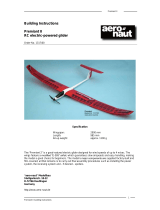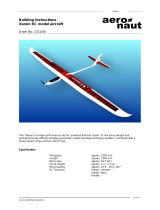
26
check that they fit correctly. Place the canopy 5 on the
fuselage and press down lightly to position the latch tongues
correctly. Carefully open the canopy, bend the latch tongues
33 slightly to one side, and apply cyano to the joint surfaces.
Straighten the latch tongues again immediately. Fig. 33
If you wish, you can paint the canopy at this stage. Please
note that you must use our MULTIPrimer, # 60 2700, prior
to painting. Mask off the edge of the canopy using tape.
Apply a very thin coat of the primer; just wipe it on and off
again, as if you were cleaning the surface. After this
treatment you can paint the canopy using any paint of your
choice.
17. Joining the wing shells
Lay the wing panels 6 / 7 (top shells) on a flat building board,
with the rear flat section making contact with the board; allow
the root area to project as shown in the illustration. Weight
down the panels at the centre section and the tip. Carefully
slide the styrofoam strip 22 under the wing leading edge
until the wing shell is fully supported, then fix the strip in that
position. Fig. 34
Apply thick cyano to the wing shells 6 / 7 along all the contact
lines of the internal structure. Don’t apply too much glue in
the areas on both sides of the spar, otherwise the spar may
not fit in its socket. Now apply cyano to the side of the wing
cover panel 8 / 9. Don’t worry about running out of time -
depending on humidity you have one or two minutes before
the glue starts to set. Now insert the wing cover panel and
immediately position if correctly; press it down evenly with
the flat of your hand, working from the aileron area towards
the thickest part of the wing. Leave the wing in this position
(no tests!) for a few minutes, because the glue takes at
least two to five minutes in order to set hard. Fig. 35
18. Installing the servos
The Nano S aileron servos are installed standing upright in
the wings. The servo leads can be drawn through to the
wing root using a length of wire with a hook formed in the
end. You may need to use servo extension leads, # 8 5031.
Place the servos in the recesses in the wing and secure
each with a drop of cyano or hot-melt glue applied to the
mounting lugs. Fig. 36
19. Installing the ailerons
Cut slots in the wing panels 6 / 7 and the ailerons 10 / 11 for
the hinges 42, as shown in Figs. 37 + 38.
Ensure that the slots are in line with each other, and are
exactly central.
Install the hinges ”dry” and check that the ailerons are aligned
correctly and move freely. Remove the ailerons again.
Push the hinges about ¼ of the way into the ailerons, apply
cyano to both sides, then immediately push them into final
position. Wipe off excess glue at the pivot line.
Allow the glued hinge joints to set hard, then assemble the
ailerons and wings again, but pushing the hinges only ¼ of
the way in. Apply cyano to both sides of the hinges as
described previously, then push the ailerons into final
position. Wipe off excess adhesive immediately. Fig. 39
20. Aileron pushrods
Glue the horns 34 in the recesses in the ailerons using cyano.
The aileron linkages are assembled from parts 38,35,34
and 37, as shown in Fig. 40.
Screw the clevis 40 on the threaded end of the pushrod 41
and set it to the correct length. Connect the pushrod using
the pushrod connector, as shown in Fig. 40.
21. Final assembly
The first step in assembling the model is to fit the tubular
spars 50 / 51 in one wing panel. Carefully insert the wing
panel in the recess in the side of the fuselage, at the same
time threading the aileron servo lead into the interior. Fit the
second wing panel on the other side and draw the servo
lead through. Fig. 41
22. Receiving system components
1. Motor: already installed.
2. Speed controller: behind the motor, supported by the
cables.
3. LiPo 2100 - 3200 flight battery: depending on the mode’s
balance, on the angled area behind the motor, or on the
shelf under the canopy and above the wing.
4. Connect the servo / speed controller cables to the receiver
and fit it in the compartment above the fuselage air vents.
Pack foam rubber round it if required.
Velcro (hook-and-loop) tape 30 + 31 is supplied in the kit for
retaining the components mentioned above.
Fig. 42
23. Centre of Gravity
Right from the outset, the RC system components should
be installed with the model’s Centre of Gravity in mind; any
corrections should be made by re-positioning these items.
The CG should be in the range 110 - 120 mm aft of the wing
root leading edge, measured at the fuselage. Fig. 43
24. Initial testing
Install all the airborne components and connect them. Set
up the control surface travels as stated below, and check
the ”sense” (direction) of the servos. All the control surfaces
must move freely. Check that the motor spins in the correct
direction, and reverse it if necessary.
25. Fitting the propeller
Fit the propeller on the motor as shown in Fig. 44. The driver
features an integral holder for the EPP spinner.
26. Basic settings (guideline only!):
Centre of Gravity: 110 - 120 mm
Longitudinal dihedral: 0°
Motor downthrust: 0 - 2°
Motor sidethrust: 2 - 3° (right)
Control surface travels measured at the point of maximum
chord
”normal” 3-D
Ailerons: 35 mm 60 mm
Elevator: 35 mm 70 mm
Rudder: 45 mm 80 mm










